Shopify vs WooCommerce: Which is Right for Your Online Store?
Statistics show that Shopify and WooCommerce are the most widely used ecommerce platforms in the world. Up to now, each platform has powered millions of online stores worldwide.
And choosing one out of the two platforms for your business could be difficult.
That’s why you need to understand the pros and cons as well as the difference between Shopify vs. WooCommerce to make the right choice.
In this article, we will provide everything you need to know across various criteria before committing to one platform.
| Key Takeaways |
|---|
|
Shopify vs WooCommerce: Quick comparison
What is Shopify?
Shopify is a cloud-based ecommerce platform that allows businesses to create and manage an online store. It offers a range of features, such as secure payment processing, shipping management, and various apps and services to enhance your store’s functionalities.
What is WooCommerce?
WooCommerce is a flexible open-source plugin for WordPress that enables small to large-sized businesses to set up and manage an online store.
What is the difference between WooCommerce and Shopify?
The differences between WooCommerce and Shopify lie in the level of control and hosting structure.
WooCommerce is a plugin for WordPress, a self-hosted content management platform. The plugin can’t work alone unless you have a WordPress site.
On the other hand, Shopify is a fully hosted platform that provides everything you need to create and run your online store smoothly, such as hosting, security, and 24/7 support. This can be a huge advantage for beginners or those who don’t want to deal with the technical aspects of running a website. However, you have less control over the design and functionality of your online store.
Shopify vs WooCommerce: ConsTable Comparison
So, Shopify vs WooCommerce: Which is the winner?
To us, the answer is Shopify.
Take a look at this comparison table between Shopify and WooCommerce and see why:
| Criteria | Shopify | WooCommerce | Winner |
|---|---|---|---|
| Pricing | Offers a variety of subscription plans with different pricing tiers Charges transaction fees: 0–2% + (2.4%–2.9% + 30 cents) |
Free to use, but requires paid hosting and additional costs for premium features Charges fees for using payment gateways |
Depending on your business needs and size |
| Sales Features | Offers a wide range of built-in sales features | Basic sales features included but requires plugins for advanced features | Shopify |
| Marketing Features | Offers built-in marketing features and integrations with third-party marketing tools | Basic marketing features included, but requires plugins for advanced features | Shopify |
| Dropshipping | Offers built-in dropshipping features and integrations with third-party dropshipping apps | Requires plugins for dropshipping functionality | Shopify |
| SEO Features | Offers built-in SEO features and integrations with third-party SEO tools | Basic SEO features included, has the advantage of WordPress SEO features | WooCommerce |
| Speed | Offers fast page loading speed | Page loading speed can be affected by hosting provider and website optimization | Shopify |
| Apps and Plugins | Offers a wide range of apps and plugins in the Shopify App Store | Large community of third-party developers creating plugins and extensions | Shopify wins for more comprehensive quality control |
| Ease of Use | User-friendly interface and simple setup process | Steep learning curve and requires technical knowledge for customization | Shopify |
| Build Time | Quick and easy setup process with pre-built templates | Longer build time due to customization requirements | Shopify |
| Scalability | Scalable infrastructure to handle high volumes of traffic and sales | Scalability depends on hosting provider and website optimization | Shopify |
| Help and Support | Offers 24/7 customer support via phone, email, and live chat | Offers community support and documentation, but limited direct support | Shopify |
| Security | Offers high-level security features, SSL certificates, and fraud prevention tools | Security depends on hosting provider and website optimization | Shopify |
| Themes and Design | Offers a variety of modern, customizable themes | Large community of developers creating themes and customization options | Shopify |
| Market Share | Powers over 4.5 million websites worldwide | Powers over 3.9 million websites worldwide | Shopify |
Overall, Shopify is the winner for pricing, sales features, marketing features, dropshipping, SEO features, speed, ease of use, build time, scalability, help and support, security, and popularity. WooCommerce is the winner for subscription fees, apps and plugins, and themes and design.
Shopify vs WooCommerce: In-depth Comparison
Pricing
Subscription fees
Shopify Subscription Fees
There are three main pricing plans offered by Shopify. They are:
- Basic Plan: $39 per month
- Shopify Plan: $105 per month
- Advanced Plan: $399 per month
Each country has different pricing offerings. The costs above apply to US sellers. See how much Shopify costs in your country by clicking here.
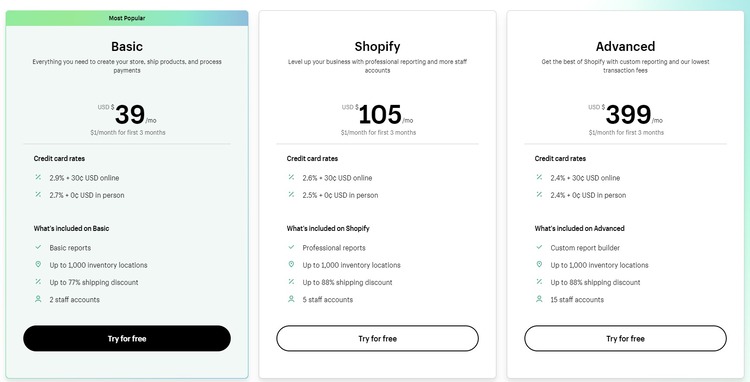
Each subscription plan comes with different features, and of course, the higher-level your plan is, the more advanced features it has. For instance, access to advanced reporting tools is only available in the Advanced Shopify Plan.
Before committing to a plan, you can click here to try Shopify for free for 3 days.
Note that with Shopify, you don’t have to pay an additional hosting fee—Shopify includes it in your monthly subscription package.
However, you still need a domain name. The price for domain name registration depends on the provider and the types of domain extensions (like .com or .net). But a domain name normally costs you between $0.99 to $30 per year.
WooCommerce Subscription Fees
WooCommerce is free to download and use. However, you need to have a WordPress site before setting up this plugin. And to have a WordPress site, you need to buy hosting and a domain name.
There is no fixed cost for hosting and a domain name because there are so many providers and many different pricing packages each provider offers. However, we estimate that hosting could cost you from $1.99 to hundreds of dollars per month, and a domain name could cost around $0.99-$30 per year. Note that many hosting providers include a free domain name for the first year.
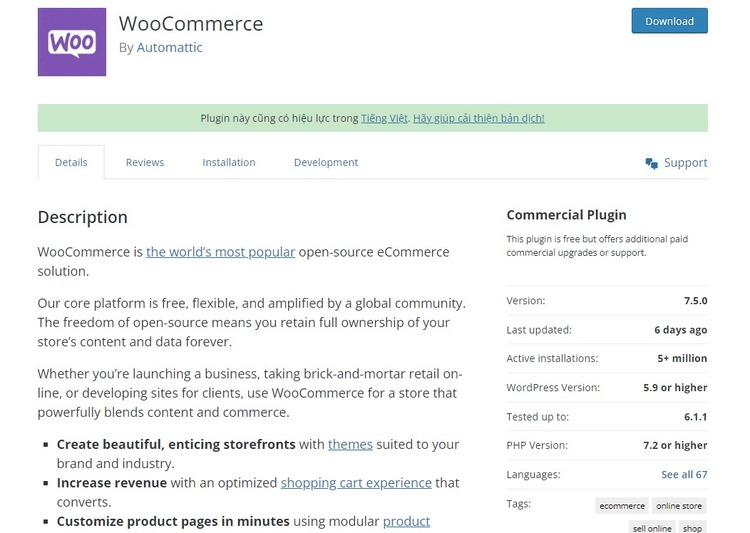
Transaction fees
If you’re just starting out with a small online store, transaction fees may not make a significant impact on your revenue. However, as your online business grows and you start processing more transactions, those fees can quickly add up. Therefore, transaction fees should be carefully considered.
Shopify Transaction Fees
There are two types of fees for each successful transaction when you use Shopify. They are credit card processing fees (charged by payment gateway providers) and Shopify transaction fees (charged by Shopify).
The credit card processing fees range from 2.4% to 2.9% + 30 cents per transaction, specifically:
- Shopify Basic Plan: 2.9% + 30¢ per online transaction; 2.7% + 0¢ in person
- Shopify Plan: 2.6% + 30¢ per online transaction; 2.5% + 0¢ in person
- Shopify Advanced Plan: 2.4% + 30¢ per online transaction; 2.4% + 0¢ in person
The additional transaction fees charged by Shopify range from 0–2% per transaction:
- 0%: To merchants using Shopify Payments
- 0.5–2%: To merchants using a third-party payment gateway (other than Shopify Payments)
WooCommerce Transaction Fees
WooCommerce doesn’t charge any transaction fees. However, you still have to pay credit card processing fees, which typically range from 2.9% to 3.3% + 30¢ per transaction, depending on your payment gateway provider. The transaction fee, as you can see, is clearly higher than that on Shopify.
The answer to whether Shopify or WooCommerce is more expensive in terms of transaction fees is unclear and can depend on various factors such as payment gateway, location, and pricing plan.
- If you use Shopify Payments, Shopify is the clear winner.
- If you don’t, WooCommerce could be the winner, but that still depends on the payment gateway provider you choose.
| Shopify | WooCommerce | |
|---|---|---|
| Subscription fees | 2.4%–2.9% + 30¢ per online transaction | Free, but required hosting and domain name to run a site |
| Transaction fees | 0–2% + pre-negotiated credit card rates | Higher credit card rates |
The verdict:
It depends on your business size and volume to decide whether Shopify or WooCommerce is more expensive.
Which one is cheaper: Shopify or WooCommerce?
It’s hard to answer the question of whether Shopify or WooCommerce is cheaper because it really depends on the package and features you want. Let’s make it clear.
First, Shopify charges monthly or yearly subscription fees, while WooCommerce doesn’t. But Shopify includes in its subscription packages many ecommerce features to run a basic ecommerce business. On the other hand, when you’re on WooCommerce, you need to buy third-party plugins to use ecommerce features included in Shopify packages. Therefore, you should think about your business needs and see if the features you need are available on Shopify and/or WooCommerce.
Second, transaction fees could be higher or lower depending on whether you use Shopify Payments (if you’re on Shopify) and the payment gateway provider (if you’re on WooCommerce).
Can you use WooCommerce or Shopify for free?
You can’t use WooCommerce and Shopify for free.
Shopify offers a free trial, but after that, you have to pay subscription fees to use it. On the other hand, WooCommerce is free to use, but you must purchase web hosting and a domain name to set up a website first..
Do you have to pay for hosting with WooCommerce or Shopify?
With Shopify, hosting is included in the monthly subscription fee. However, with WooCommerce, businesses must pay for web hosting separately. The cost of hosting for WooCommerce can vary depending on the hosting provider and the specific hosting plan that you choose.
Sales Features
As robust ecommerce platforms, both platforms also offer a range of must-have sales features, such as:
#1. Product Management
Both Shopify and WooCommerce have an intuitive interface for managing products. However, we can see that Shopify is slightly more intuitive and ecommerce-friendly due to its total focus on ecommerce.
 Shopify’s product management interface
Shopify’s product management interface
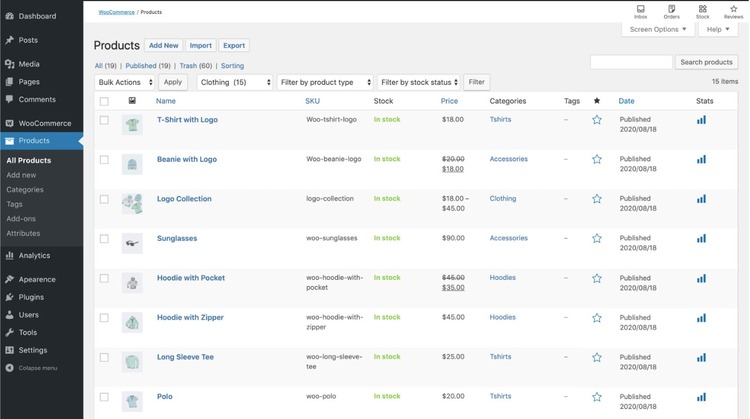 WooCommerce’s product management interface
WooCommerce’s product management interface
#2. Payment Options
Different customers have different preferences when it comes to payment options. Some customers may prefer to use credit cards, while others may prefer to use digital wallets or bank transfers. By offering a variety of payment options, you can cater to a wider range of customers and increase the likelihood that they will choose to make a purchase on your platform.
Shopify integrates with more than 100 payment gateway options, including its own payment gateway, Shopify Payments as well as other third-party payment gateways. To choose one gateway, you just have to pick one from a list of the already-integrated payment gateways. WooCommerce offers fewer payment gateway options (84 options); and it requires businesses to set up their own payment gateway accounts.
#3. Shipping and Fulfillment
Both platforms offer excellent built-in shipping and fulfillment features, and you can find them right in one dashboard. Users of both ecommerce platforms can access features like same-day delivery, package pick-ups, tracking information, international shipping, and more. But just as we said, WooCommerce relies more heavily on third-party plugins to provide advanced shipping and fulfillment options, while Shopify mostly doesn’t.
It’s also worth noting that Shopify exclusively offers Shopify Fulfillment Network (SFN) to Shopify merchants who meet their requirements. SFN is a quicker and cheaper solution to fulfillment.

#4. Sales Channels
Both Shopify and WooCommerce allow you to integrate your ecommerce solution with multiple sales channels, such as Amazon, eBay, Facebook, etc., through apps and plugins. This helps you reach more customers and increase sales.
#5. Discounts and Promotions
Both WooCommerce and Shopify offer out-of-the-box features to create discounts and promotions, but generally, Shopify has a more intuitive interface for creating and managing them.
#6. POS (point of sale) system
Shopify has a built-in POS system that allows merchants to sell products in person at a physical store or pop-up shop. So you don’t have to set up one. Meanwhile, WooCommerce does not have a built-in POS system, and merchants have to integrate with third-party POS systems.
#7. Abandoned cart recovery
This feature is available on both Shopify and WooCommerce. However, WooCommerce requires you to install the plugin while it’s a built-in feature on Shopify.
*Note that the specific features available may vary depending on the pricing plan and any third-party apps or plugins that are used.
The verdict:
Shopify has a slight advantage over WooCommerce due to its built-in ecommerce features.
Marketing Features
When it comes to marketing features, both Shopify and WooCommerce offer a range of tools to help businesses reach new customers and increase sales. Especially, merchants on WooCommerce can take advantage of marketing features on both WooCommerce and WordPress. Here are the features both platforms offer.
- SEO optimization: Both Shopify and WooCommerce provide built-in SEO optimization tools, such as custom URLs and sitemaps to help businesses improve their search engine rankings.
- Email marketing: Both platforms allow businesses to create and send email campaigns to their subscribers based on their purchase history, abandoned carts, and others.
- Social media integration: Both platforms allow businesses to connect their online stores to their social media profiles (like Facebook and Instagram) and promote their products on social media.
- Discount codes and coupons: This is a built-in feature available on both WordPress and Shopify.
- Product review and rating: This feature is available on both platforms. However, it is built-in on WooCommerce, while Shopify requires a third-party app to set it up.
- Abandoned cart recovery: WooCommerce requires you to install a third-party plugin while Shopify doesn’t.
- Upsells and cross-sells: Both Shopify and WooCommerce enable users to recommend related products to customers during the checkout process.

The verdict:
Shopify is the winner due to having more built-in marketing features.
Dropshipping:
Dropshipping is recently a popular business model that involves selling products without stocking inventory. Both Shopify and WooCommerce offer a wide range of dropshipping apps, allowing you to:
- Integrate with third-party dropshipping apps and plugins
- Import product information and images from supplier
- Automate order fulfillment and track updates
- Integrate various payment gateways and currencies
- Have advanced shipping options and rates calculation
- Have user-friendly interfaces and customizable templates
Shopify has a significant advantage over WooCommerce when it comes to dropshipping, as it offers integration with more than 450 dropshipping apps. On the other hand, WooCommerce users have access to around 145 dropshipping plugins, which is significantly lower than Shopify’s offering.
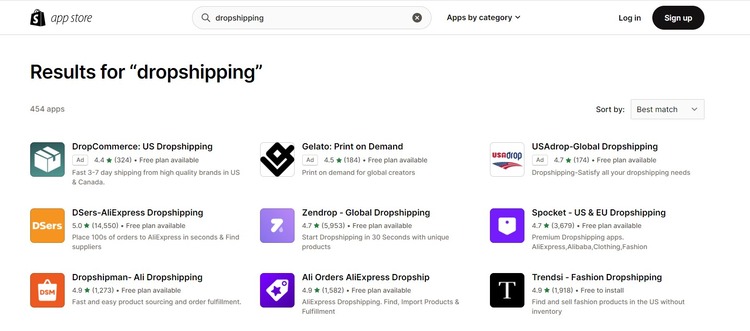
The verdict:
Shopify wins because it has more dropshipping apps than WooCommerce.
SEO Features
Both Shopify and WooCommerce have similar SEO (Search Engine Optimization) features, such as:
- Customize page titles, meta descriptions, and URLs.
- Add alt tags to images for improved post reach and SEO.
- Create and edit robots.txt and sitemap.xml files.
- Integrate with Google Analytics to track website traffic and performance.
- Have mobile-friendly design and responsive themes to improve user experience.
However, there are some differences between the two platforms.
- Shopify includes built-in SSL certificates, which can improve website security and search engine ranking. Meanwhile, on WooCommerce, you have to find and pay for an SSL certificate separately.
- WooCommerce offers more control over website hosting and server configuration, which could be good if you’re good at technical skills. However, Running an online store on WooCommerce requires installing many plugins, which can negatively impact your page speed and SEO ranking.
- WooCommerce is built on WordPress, which is known for its SEO-friendly architecture. WordPress has a variety of SEO plugins available, such as Yoast SEO and All in One SEO Pack, which can enhance the platform’s SEO capabilities.
The verdict:
WooCommerce’s integration with WordPress may give it a slight advantage in terms of SEO features.
Speed
Your page load time is a critical factor that can impact user retention on your website. To speed up the website, both Shopify and WooCommerce allow integration with Content Delivery Networks (CDNs), optimizing images and caching plugins.
However, there are still some differences.
Shopify is a fully-hosted platform, which means it takes care of all the technical aspects of your website, including speed. The average server response time for Shopify is 386ms, which is considered pretty fast.It has ranked first among all the ecommerce platforms.
WooCommerce, on the other hand, has ranked fifth. The fact is that it is a self-hosted platform, which means that the speed of your website depends on your hosting provider. Plus, you need many plugins to add ecommerce features to your WooCommerce store, which potentially slows down your page. In fact, the average server response time for WooCommerce reached 776 milliseconds, almost doubling the speed of a Shopify store.

The verdict:
Shopify is the winner in this round because it has faster store speed.
Apps and Plugins
Both Shopify and WooCommerce offer a wide range of apps and plugins to enhance the functionality of your ecommerce store. These tools can help you with marketing and sales, customer service, inventory management, shipping and fulfillment, and much more. There are currently over 8,000 apps available in the Shopify App Store and over 55,000 plugins in the WooCommerce directory.
Actually, there is nothing much to compare in terms of apps and plugins, as both platforms are giants in ecommerce, with many years of experience in offering users the necessary tools.
However, one newest feature unique to Shopify is Shopify Flow, allowing merchants to create automated workflows to help streamline their business operations. WooCommerce doesn’t have such a similar feature.
The verdict:
Shopify wins because it has a larger selection of apps specifically designed for its merchants compared to WooCommerce
Ease of Use
Shopify is a hosted platform that comes with a user-friendly interface, making it easy to set up an online store. It has a built-in drag-and-drop builder that allows you to customize your store’s design and layout without touching a line of code. Additionally, it offers an intuitive dashboard that lets you manage your products, orders, and customer data effortlessly. Shopify’s mobile app also enables you to monitor the performance of your Shopify store and manage your online business on the go.

WooCommerce, on the other hand, is a self-hosted platform that requires some technical knowledge to set up and customize. However, it offers more flexibility and control over your store’s design and functionality. With WooCommerce, you have complete access to your site’s code, allowing you to add custom features and integrations.
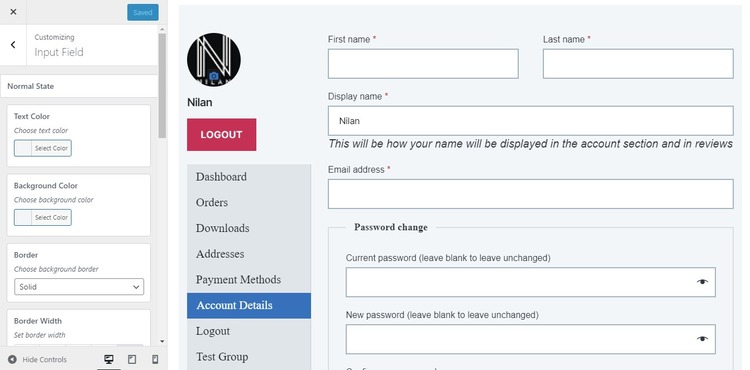
The verdict:
Shopify is better as it is generally considered easier and more intuitive to use.
Build Time
The time required to build an online store can vary depending on several factors. These may include the size and complexity of the store, the level of familiarity with Shopify and WooCommerce, and the internet speed.
Shopify is an all-in-one solution that comes with hosting, templates, and an easy-to-use drag-and-drop website builder. The steps to create a site are:
- Open an account
- Choose a template and configure it
- Add products
- Install plugins
- Write your product copy
- Test everything
You can have a fully functional online store up and running in a matter of hours. But actually, the build time totally depends on your experience—it could take from less than an hour for experienced users to set up to perhaps a few days for those without experience.
Unlike Shopify, WooCommerce requires a bit more technical knowledge and set-up time. You’ll need to research and purchase your own hosting provider, install WordPress, and then install the WooCommerce plugin. This process can take several hours to a few days.
The verdict:
In terms of build time, Shopify wins because of its fully hosted nature.
Scalability
Both Shopify and WooCommerce are highly scalable and can handle large amounts of traffic and orders. They allow users to create multiple online stores all under a single account and offer solutions for international expansion, including multilingual support and currency conversion.
However, there are some differences that make Shopify a better choice in terms of scalability.
Shopify
Shopify, with its cloud-based hosting, makes it more scalable than WooCommerce (self-hosted), as it can handle larger volumes of traffic and orders without compromising site speed.
Shopify’s enterprise-level plans offers advanced features for scaling, such as dedicated account management and access to Shopify Plus’ wholesale and multi-channel sales capabilities.
WooCommerce
To scale up on WooCommerce more likely depends on the quality of hosting and server resources, as well as the optimization of the site’s code and content.
As an open-source platform, WordPress allows greater flexibility and customization but also requires more technical expertise to scale effectively.
The verdict:
Shopify is better for businesses that scale up quickly.
Help and Support
Both Shopify and WooCommerce provide a comprehensive knowledge base that includes tutorials, guides, and FAQs to help users find solutions to their problems. Community forums are also the place where users can ask questions, share their experiences, and get help from other users and experts.
However, there are several differences in terms of help and support, which makes Shopify a clear winner.
- 24/7 support: Shopify offers 24/7 support via phone, email, and live chat, while WooCommerce does not provide live chat, phone, or email support.
 Shopify’s support channel
Shopify’s support channel
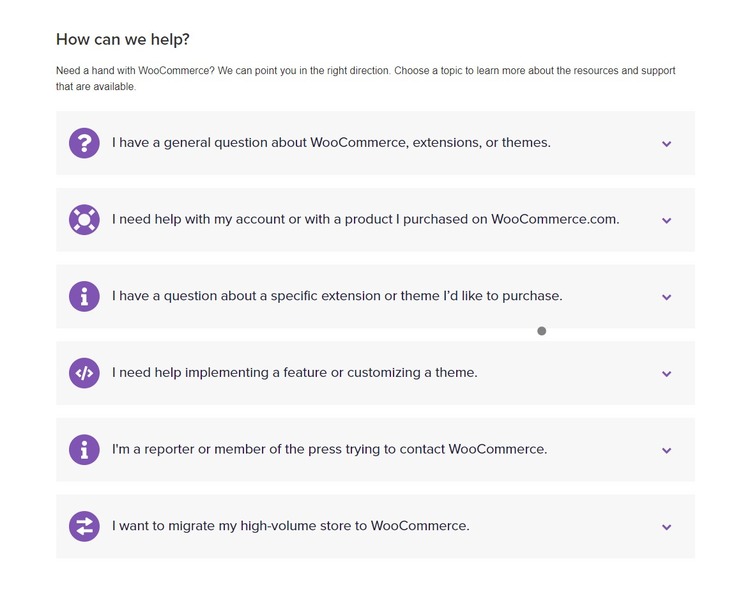 WooCommerce’s FAQs support
WooCommerce’s FAQs support
- Priority support: Shopify provides priority support to users on higher-tier plans, while WooCommerce does not offer any priority support options.
- Social media support: Shopify supports its users through social media channels like Twitter, while WooCommerce does not have an official presence on social media for support.
- Dedicated support team: Shopify has a dedicated support team that helps merchants with technical issues, while WooCommerce relies on a network of third-party developers and freelancers to provide support.
The verdict:
Shopify is the winner as it has better customer support.
Security
Both Shopify and WooCommerce use SSL (Secure Sockets Layer) encryption to protect sensitive data like credit card information during transactions. They also provide options for two-factor authentication to protect the login process.
However, Shopify is more secure than WooCommerce. Here are the reasons:
- Shopify is, by nature, a fully-hosted platform. This means this ecommerce platform takes care of security updates and monitoring, delivering faster updates and patches to address any vulnerabilities. On the other hand, WooCommerce is self-hosted, which means the responsibility for security updates and monitoring falls on the merchant.
- Shopify is PCI compliant. This is important for merchants processing credit card payments, as it ensures that the ecommerce platform has the necessary security measures in place to protect against fraud and data breaches. While WooCommerce is not PCI-compliant out of the box, it can be made compliant by using additional plugins or extensions.
- Shopify includes an SSL certificate for free to all subscription plans, while WooCommerce requires merchants to obtain their own SSL certificate.
- Shopify has a robust fraud analysis and prevention system built in, which uses machine learning algorithms to detect fraudulent transactions. WooCommerce, on the other hand, relies on third-party plugins or extensions for this functionality.
The verdict:
Shopify has an advantage in terms of security updates and monitoring, PCI compliance, and fraud analysis and prevention.
Themes and Design
When it comes to themes and design, Shopify and WooCommerce both offer a wide variety of themes. (WooCommerce merchants can make use of a large library of themes on WordPress.)
However, there are still some differences in the way the two ecommerce platforms approach themes and design.
- WooCommerce has fewer free themes available than Shopify. WooCommerce has 3 free themes available, while Shopify has 12 free themes.
 WooCommerce theme store
WooCommerce theme store
- Shopify’s themes tend to have a more consistent design aesthetic compared to WooCommerce’s themes, which can vary in style and quality.
 Shopify theme store
Shopify theme store
The verdict:
Shopify wins in terms of themes and designs.
Market Share
According to BuiltWith, Shopify has been the most popular ecommerce platform, currently powering over 4.5 million websites worldwide(statistics in 2023). WooCommerce, on the other hand, is the third most popular ecommerce platform, with over 3.9 million active installs. In fact, WooCommerce ranks lower compared with last year (2nd place, after Shopify).
- Shopify: 14.82% – powering over 4.5 million websites
- WooCommerce: 12.77% – powering over 3.9 million websites
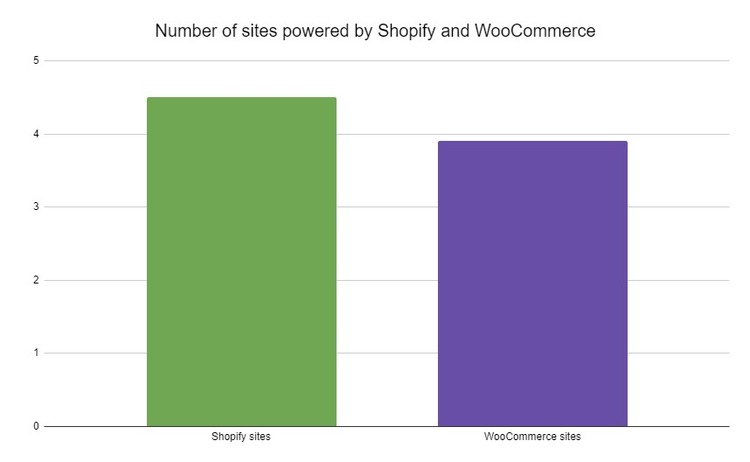
The verdict:
Shopify is more popular because it has a bigger market share.
Which one is more popular: Shopify vs WooCommerce?
The answer is Shopify, according to BuiltWith. Shopify is more popular than WooCommerce, with a market share of 14.82% compared to WooCommerce’s 12.77%.
Shopify vs WooCommerce: FAQs
Is Shopify better than WooCommerce?
It depends on the specific needs of your ecommerce business, as both ecommerce platforms have their strengths and weaknesses, and there is no one-size-fits-all solution.
Should I switch from WooCommerce to Shopify?
If you find that WooCommerce doesn’t meet your needs, it may be worth considering a switch to Shopify. Here are several aspects that make
Shopify better than WooCommerce:
- User-Friendly Interface: Shopify’s interface is more user-friendly and easier to navigate compared to WooCommerce, especially for beginners.
- Hosting and Security: Shopify is a hosted platform, which means that they take care of hosting your website and ensuring its security. This eliminates the need for you to manage your own hosting and security, which can be a daunting task for some users.
- App Integrations: Shopify has a vast array of apps and integrations that can enhance your online store’s functionality, and some apps are unique to Shopify.
- Customer Support: Shopify offers 24/7 customer support, which is not available with WooCommerce. This can be especially helpful if you encounter technical issues or need help setting up your store.
- Scalability: Shopify is better suited for scaling up your business than WooCommerce.
Why use WooCommerce over Shopify?
There are several reasons why one might choose to use WooCommerce over Shopify:
- Upfront cost: WooCommerce is a free, open-source platform, whereas Shopify requires a monthly subscription fee.
- Customization: WooCommerce is highly customizable, allowing for more flexibility and control over the design and functionality of your online store.
- Ownership: With WooCommerce, you have complete ownership and control over your online store and its data. Shopify, on the other hand, is a hosted platform, which means you are limited in terms of control and ownership.
- WordPress Integration: WooCommerce is a plugin for WordPress, the most popular CMS in the world. This is advantageous especially for businesses that rely on content-driven strategies.
Can you migrate your store between Shopify and WooCommerce?
Yes, it is possible to migrate your online store between Shopify and WooCommerce. There are several migration tools available, such as automated migration plugins or manual migration services, that can help to transfer products, customer data, and other important information from one platform to the other.
Shopify vs WooCommerce: Conclusion
In conclusion, Shopify and WooCommerce are both powerful e-commerce platforms that offer unique advantages depending on your specific needs. Shopify provides an all-in-one solution that is easy to use, scalable and has a large ecosystem of apps. It’s a great option for businesses that want to get up and running quickly with minimal setup and maintenance.
On the other hand, WooCommerce is a flexible and customizable platform built on top of WordPress. It provides more control over your site and is suitable for businesses that require specific customization and have a larger budget for development. WooCommerce is a great option for businesses with existing WordPress sites, as it integrates seamlessly and has a familiar interface.
Who should use Shopify? And who should use WooCommerce?
Who should use Shopify:
- Those who prioritize ease of use and convenience over customization.
- Those who are willing to pay a monthly fee.
- Those who are not proficient in web development and coding and want the platform to handle hosting, security, and updates.
- Those who prioritize scalability and growth potential for their online store.
- Those who want to sell across multiple channels, such as social media and marketplaces.
Read More: The Most Comprehensive Guide of WooCommerce to Shopify Migration
Who should use WooCommerce:
- Those who prioritize customization, full control and flexibility over ease of use.
- Those who have experience with web development and coding or are willing to hire a developer.
- Those who want to take advantage of WordPress and blogging capabilities.
- Those who want to have lower ongoing costs and greater control over hosting and security.





